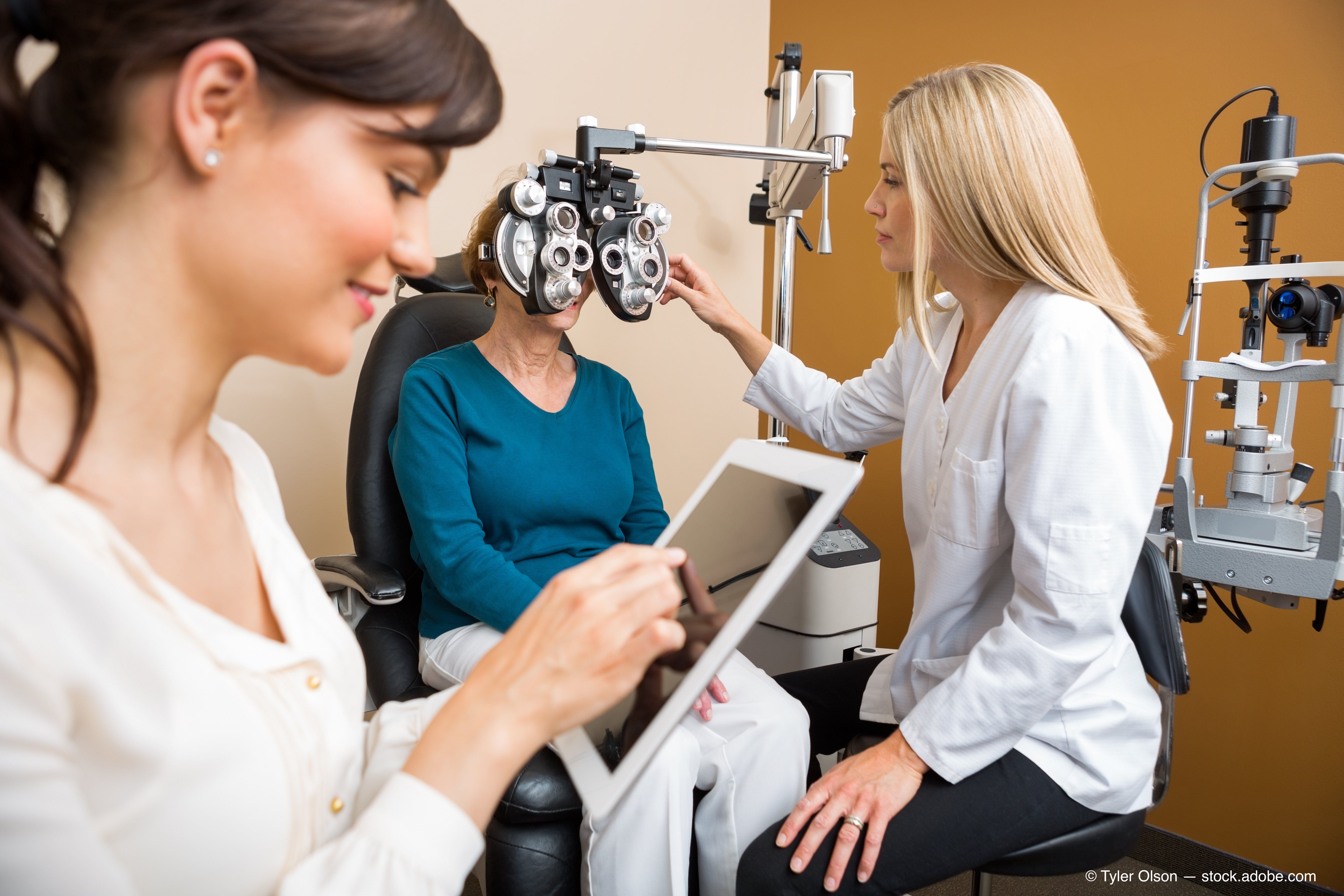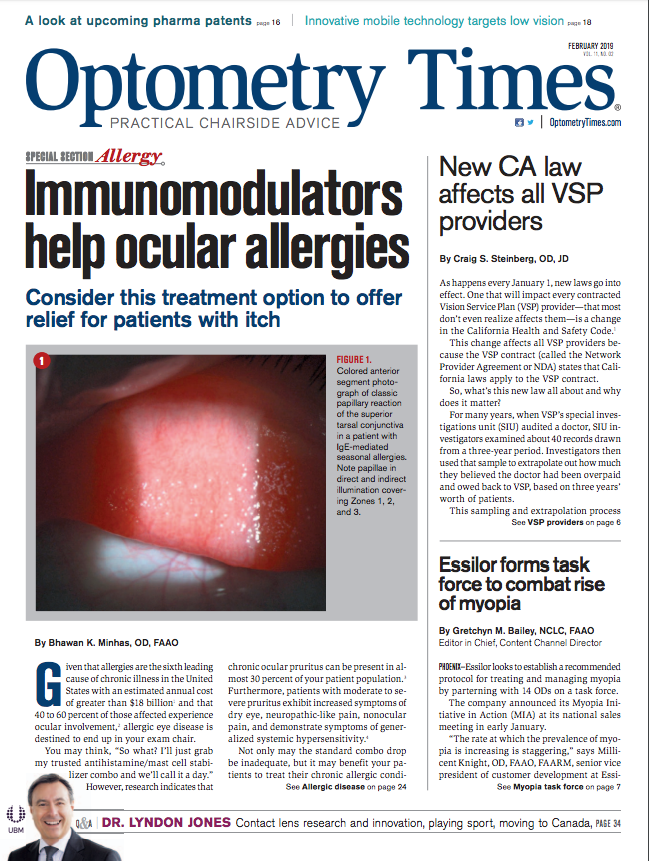Innovative mobile technology targets low vision


Blindness is the most feared medical condition in the nation.1 Second only to the fear of death is the fear of living a life without the benefit of the sense of sight.2
Modern clinical optometry allows for the effective rehabilitation of patients with visual impairment to function and navigate the world. As modern medicine becomes more “high tech,” so are the devices for helping those with visual impairment.
These technological advances in low vision represent an opportunity for ODs to differentiate their practices from other healthcare providers by providing innovative services that improve outcomes for the visually impaired.
Previously by Dr. Wong: Applying precision medication to glaucoma and genomics
In a modern world where technology is advancing at an exponentially growing rate, it is important the primary care optometrists keep up with these technologies.
Modern concepts of disability
Modern theories teach that disabilities are better understood with the social model of disability instead of the more intuitive and traditional medical model of disability.3
The social model of disability is based on an individual's interaction with his environment in contrast with society’s concept of normalcy or the normal body.
We depend on technology and evolving modern conveniences to function in our daily lives. Many of us could not function without electricity, automobiles, trains, subways, smartphones, GPS navigation systems, TurboTax software, or microwave ovens in our current lifestyles.
Read more technology articles here
High myopia was considered a severe disability a century ago. But with more affordable access to spectacles and contact lenses in the 21st century, most cases of myopia no longer represent a disability in today’s developed society.
Prevalence of low vision
In the United States alone, both the prevalence and incidence of persons with visual impairment will likely double by the year 2050.4 It’s important that ODs find ways to take care of the aging population.
The most common complaint of low-vision patients is difficulty reading.5 Thus, most of the technology developed today assists these patients with near tasks, such as reading.
Let’s review clinically relevant, portable low-vision devices and applications.
These applications include indications for the future of low vision. Moreover, patients today expect their optometrists to be familiar and fluent with these technologies.
KNFB Reader
KNFB is an app that performs text-to-speech and text-to-Braille.6 It can speak back large amounts of text. Within the app, the patient must take a photo or import a photo that contains text; the app will analyze the text and read it back to the user.
Such text can include mail, price tags, books, and magazines. It can even provide nutritional information on a food label. The app helps users obtain the most accurate photo by utilizing verbal and tactile alignment cues.
KNFB Reader is able to recognize and read in over 10 languages, with more being added as it continues to update. The app is available for iOS and Android devices.
Be My Eyes
Be My Eyes connects visually impaired individuals with sighted volunteers to aid with visual assistance in everyday life.7 The app links people through live video calls on demand when needed.
This free service is designed for easy use for the visually impaired: A user must simply open the app and touch the blue screen to make a call. Service is currently available in over 150 countries and more than 180 different languages. Be My Eyes is available for iOS and Android devices.
Seeing AI
Seeing AI is a free app developed by Microsoft that allows a visually impaired person to turn “the visual world into an audible experience.”8
This app makes use of the science behind artificial intelligence (AI) to turn anything in the world into a verbal description.
It can accurately read short amounts of printed material; describe nearby people, text, and objects; describe perceived color; read handwritten text; and identify currency bills when paying with cash. Seeing AI is available for iOS and Android devices.
TapTapSee
TapTapSee is a mobile camera app that utilizes CloudSight image recognition API.9 It uses a device’s camera and voiceover functions to take a picture or video of an object and identifies it out loud for.
Double-tapping the right side of the camera screen takes a picture and double-tapping the left side of the screen takes a video. TapTapSee accurately analyzes and identifies objects within a few seconds.
OrCam
OrCam is small camera that attaches to the temple of a patient’s glasses.10 It makes use of hand gestures and verbal commands to read text, tell the user the date and time, recognizes faces once taught, and identify products via bar code once taught.
This device is known for its portability and accurate text-to-speech capability. OrCam is able to see a full page of a text and read it back to the user.
IrisVision
Most of the devices already mentioned help patients with the world that is within an arm’s length of reach.11 IrisVision is a wearable virtual reality device that aids with distance viewing.
It wears much like a pair of glasses with a headstrap. But instead of viewing through lenses, the patient views projected images on a Samsung Galaxy S7 smartphone.
It boasts up to a 70-degree field of view with an adjustable “IrisBubble” that allows users to zoom in on a certain aspect of the projected scene.
A unique feature of IrisVision is its ability to change the contrast of the viewed scene being viewed to a high-contrast black and white scene.
BuzzClip
BuzzClip is a newer device to aid visually impaired persons with mobility.12 Rather than replace the common red and white mobility cane often used, BuzzClip is meant to supplement it.
BuzzClip is a small, wearable device that makes use of soundwave technology to alert users via vibration when an obstacle is in the user’s path. While the standard mobility cane works well to alert users to hazards on the ground, BuzzClip can be placed or held higher up to warn patients of hazards that are within their headspace.
The device will vibrate when an object is presented in front of it, allowing users to navigate around objects that may be in their way.
Related: Why ODs should embrace new technologies in eye care
Learning Ally
Learning Ally is a nonprofit edtech organization that serves dyslexic, blind, and visually-impaired students.13
This solution provides struggling readers with equitable access to the books they want to read and the grade-level content they need to read. With the largest library of human-read audiobooks and a suite of educator tools and resources, students become engaged and independent learners.
Mobile technology
Smartphones, such as the iPhone, contain useful apps for visually impaired patients, such as the big clock and talking calculator.
The big clock increases the size of the phone’s clock display. The talking calculator includes a customizable built-in directory users can record in their own voices. Button names are spoken aloud when a finger is placed over them and selected by double tapping.
Included in iPhone
• Voiceover
• Screen reader
• Siri
• Speak selection
• Email, text, web page, book reader
• Adjustable voice dialect, speaking rate
• Dictation
• Voice-to-text microphone
• Zoom
• Built-in magnifier (100 to 500 percent)
• Font adjustment
• Color invert or grayscale
• Braille displays
• 40 Bluetooth wireless Braille displays
Apple communities
AppleVis is a community-powered website for blind and low-vision users of Apple products, including the iPhone, iPad, and Apple Watch.14 The website features a comprehensive list of helpful apps.
Conclusion
Advances in low-vision technology allow for visually impaired patients to interact with their environment in ways that were not possible a few years ago.
References:
1. Scott AW, Bressler NM, Ffolkes S, Wittenborn JS, Jorkasky J. Public attitudes about
eye and vision health. JAMA Ophthalmol. 2016 Oct 1;134(10):1111-1118.
2. Michaels, DD. Visual optics and refraction- a clinical approach. C.V. Mosby Company. 1986. Print
3. American Optometric Association. The optometric care of patients with disabilities. Available at: https://www.aoa.org/about-the-aoa/ethics-and-values/ethics-forum/the-optometric-care-of-patients-with-disabilities. Accessed 12/27/18.
4. Chan T, Friedman DS, Bradley C, Massof R. Estimates of incidence and prevalence of visual impairment, low vision, and blindness in the United States. JAMA Ophthalmol. 2018 Jan 1;136(1):12-19.
5. Brown JC, Goldstein JE. Chan TL, Massof R, Ramulu P. Low Vision Research Network Study Group. Characterizing functional complaints in patients seeking outpatient low-vision services in the United States. Ophthalmology. 2014 Aug; 121(8): 1655-62.
6. KNFB Reader. KNFB Reader, LLC and Sensotec. Available at: https://knfbreader.com/the-app. Accessed 12/27/18.
7. Be My Eyes. 2018. https://www.bemyeyes.com/. Available at: https://www.bemyeyes.com/get-started. Accessed 12/27/18.
8. Seeing AI. Microsoft. Available at: https://www.microsoft.com/en-us/seeing-ai. Accessed 12/27/18.
9. TipTapSee. How it works. Available at: https://taptapseeapp.com/instruction.html. Accessed 12/27/18.
10. OrCam. OrCam MyEye 2: For the blind and visually impaired. Available at: https://www.orcam.com/en/myeye2/. Accessed 12/27/18.
11. IrisVision. How it works. Available at https://irisvision.com/how-irisvision-works/. Accessed 12/27/18.
12. iMerciv. BuzzClip user guide. Available at: https://imerciv.com/user-guide/index.shtml. Accessed 12/27/18.
13. Learning Ally. What drives us. Available at: https://learningally.org/About-Us/Overview. Accessed 12/27/18.
14. AppleVis. iOS apps developed specifically for blind or low vision users. Available at: http://www.applevis.com/apps/ios-apps-for-blind-and-vision-impaired. Accessed 12/27/18.

Newsletter
Want more insights like this? Subscribe to Optometry Times and get clinical pearls and practice tips delivered straight to your inbox.